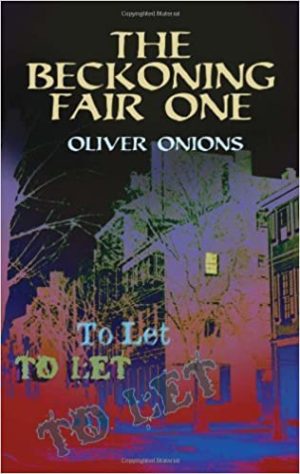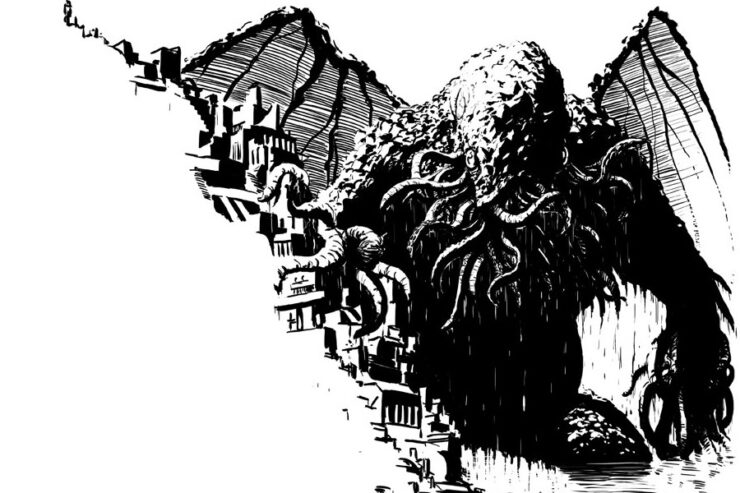Welcome back to Reading the Weird, in which we get girl cooties all over weird fiction, cosmic horror, and Lovecraftiana—from its historical roots through its most recent branches.
This week, we cover Oliver Onions’ “The Beckoning Fair One,” first published in 1911 in his Widdershins collection. Spoilers ahead.
“I don’t say I don’t love my work—when it’s done; but I hate doing it. Sometimes it’s an intolerable burden that I simply long to be rid of.”
At forty-four, writer Paul Oleron has grown tired of roughing it in garrets. Crossing a rundown square, he notices precarious “To Let” boards in front of a red-brick building that, while it’s seen better days, at least had better days to begin with.
No one’s tenanted the house for years, so Paul’s able to rent the first floor. He overspends having his five rooms cleaned and repainted, then furnishes them with a long-stored bequest from his grandmother. He appreciates the old-fashioned elegance—there’s even a curious closet off the kitchen once used for powdering wigs! Window-seat boxes yield no treasures when pried open, only a mysterious triangular sack with buckles and straps.
Renovations completed, Paul returns to his work-in-progress, Romilly Bishop. Noise in the square distracts him, as does speculation about his rooms’ history. More concerning, he’s losing interest in the novel. Maybe he needs to rewrite from scratch!
His friend, Elsie Bengough, visits. She’s a journalist, “large, showy, fair as butter, pink as a dog-rose” and given to “explosive utterances.” She admires his writing, of which she’s a perceptive first reader. Believing Romilly Bishop could make Paul’s name, Elsie’s appalled at the proposed rewrite—maybe biased by the protagonist based on herself. She identifies the mysterious sack as a harp wrap. Less usefully, she predicts he’ll never finish Romilly here.
Paul resents her pessimism and. It’s florid Elsie, not he, who doesn’t “fit” the house’s aesthetic. He’s known her for 10 years and never dreamed of proposing, and now he’s glad of it. Realizing Romilly—Elsie—can’t be his fictional ideal, he decides to burn the manuscript. Paul fetches it, but hesitates. The kitchen tap is dripping, with a “tinkling gamut of four or five notes…sweet and dulcimer-like.” Listening, he dozes off.
Mrs. Barrett, a neighbor’s wife, keeps house for Paul. Overhearing him humming the kitchen-tap “tune,” she identifies it as “The Beckoning Fair One,” an old air usually accompanied by harp.
Buy the Book


Star Eater
As Paul’s attachment to the house grows, so does Elsie’s aversion. When she retrieves Romilly from the window seat to argue its value, she cuts her hand on an exposed nail—though Paul could’ve sworn he removed them all. Elsie’s reactions as he bandages her wound give away that she’s in love with him, an irritating idea.
Next time Elsie visits, her foot breaks through a solid step. The house doesn’t want her—Paul doesn’t want her. She limps off, refusing his assistance—let her keep some pride.
That night, Paul hears the rustling crackle of an invisible woman combing her hair. He flees to a pub, garnering stares. He’ll never return to the house—no, he will. The danger’s for Elsie, not him.
Next day Barrett sends his wife’s resignation as Paul’s housekeeper, hinting it’s because of Paul’s sinful relationship with Elsie! Paul confronts him with little satisfaction. He notices the other square dwellers looking askance at him. He lies to Elsie about traveling and warns her about Barrett’s suspicions. She sees through the lies as excuses to drop her. Consider her dropped, but—if Elsie ever feels Paul needs her, she’ll come.
Paul, feeling freed, consults the local vicar about the house’s history. Its last resident, an artist named Madley, starved himself to death. Unfazed, Paul determines to open himself to the house and the Beckoning Fair One who’s his co-tenant.
He waits. He watches. The Fair One proving coy, he takes a day trip to feign indifference. Returning, he hears the hair-combing, sees his comb moving in an invisible hand. His courtship intensifies. Growing agoraphobic, he has his food delivered daily along with flowers for the Fair One. He closes blinds, shunning daylight, and stations himself at his bedroom door, from which he can see all his rooms. He’s preparing himself for a Marriage, but his Bride remains elusive. At last he realizes he must destroy the manuscript that idolizes Romilly-Elsie, the Fair One’s rival.
As Paul burns the pages, he hears Elsie pleading at his door. He ignores her. When she leaves, he sees a shadow “light as fleece” take shape in the kitchen.
Food, flowers, and telegrams accumulate untouched at Paul’s door; he lies on his bed forgetful of work, actively fighting memories of Elsie. She has no tact, interfering with his new… experiences. At the moment of her Rival’s triumph, Elsie actually enters the house. Paul feels the kiss on his lips change to gnashing. He shouts a warning as the horror departs, leaving him sick and helpless on the bed. Elsie must have come to nurse him. From the kitchen she cries out his name. Silence follows.
Paul’s too weak to investigate. Besides, his true heroine—winsome, capricious, jealous, and altogether evil—returns to press a breath-stealing kiss on his lips.
A crowd gathers before the house. Inside police inspectors find rotting food and flowers, and in the powdering closet, something wrapped in a harp-sack. In the bedroom lies an emaciated Paul Oleron. Shielding the confused man from the angry crowd, they hurry him into a cab. The sack-wrapped bundle they remove to another vehicle.
Paul’s cab moves down the square. The other vehicle goes in the opposite direction, toward the mortuary.
What’s Cyclopean: Elsie is, alas, “given to sudden and ample movements and moist and explosive utterances,” with a “florid superfluity of build.”
The Degenerate Dutch: Paul—House-Paul, at least—is prone to nasty generalizations about women. We’re “devils” with an “illogical, dogmatic way” about us. Women who “earn their own living” deceive men by acting like friends. Et cetera.
Weirdbuilding: Before-Paul seems to have thought of Elsie as “his Beatrice, his vision!”
Libronomicon: Romilly Bishop is forever frozen at Chapter 15, before the pages are sacrificed to the fire. Authors, always back up your work!
Madness Takes Its Toll: Supernatural “anemia of the soul” must be contagious, as our prim narrator suggests that once it’s set in, “the sane soul turns appalled away, lest not merely itself, but sanity should suffer.”
Anne’s Commentary
Prior to writing 40-plus novels and six collections of ghost stories to, George Oliver Onions worked as a commercial artist—and who but an artist would describe the same freshly-painted white walls as tender elderflower or meadowsweet or pith, depending on his protagonist’s emotional state. Painterly, too, is his skill in creating atmosphere through the description of light: a “lozenge of moonlight, almost peacock-blue by contrast with his candle-frame”; the “blood-red half-light of a photographer’s darkroom” with which Paul’s crimson blinds drown his rooms; the way daylight’s “last trace of sallowness” surrenders to the glow of an evening fire. Onions’s prose is a delight, or terror, to the mind’s eye.
“The Beckoning Fair One” has garnered much praise from weird fiction’s heavy-hitters. Algernon Blackwood calls it “the most horrible and beautiful [story] ever written on those lines.” Robert Aickman judges it “one of the (possibly) six great masterpieces in the field.” Lovecraft has been accused of admiring Onions, but he wrote J. Vernon Shea that he “didn’t care much for the various tales” in Ghosts in Daylight. Never mind, Oliver—Gahan Wilson says you “did as much as anyone to move phantoms and other haunts from dark, Gothic dungeons to the very room in which you presently sit.” To be sure, few Gothic dungeons are painted elderflower white. I want elderflower walls now, unless they attract succubi. Succubi are so high-maintenance, as Paul Oleron discovers.
You could read “Fair One” as pure psychological suspense, with the ghostly goings-on mere figments of Paul’s deteriorating mental state. That’s if you view Paul as a largely unreliable narrator, but I think Onions hints at something genuinely supernatural. We’re deep enough in Paul’s point-of-view not to know whether he was discontented with Romilly Bishop pre-move. Elsie’s astonishment at his change of literary heart suggests, rather, enthusiasm. His disenchantment is suspiciously abrupt, as if some sinister force instantly seizes upon latent seeds, or sows them itself. Paul speculates that a house and its tenant could stand in as intimate a relation as the body to its soul. Perhaps he’s becoming so attached to the house he’ll haunt it after death. Perhaps a tenant before him was so attached.
Given that powdering-closet, I’d date Paul’s harpist co-tenant to the 18th century. “The Beckoning Fair One” is an actual folk air also known as “Symlen Ben Bys”; Edward Jones in Musical and Poetic Relicks of the Welsh Bards (1784) describes it as “a favorite tune of the great pastoral poet Dafydd ap Gwilym, who flourished about the year 1400. He wrote a poem in its praise, wherein he informs us that he learned to play it on his harp.” Paul’s co-tenant can also play the song on a leaky faucet.
As best I can translate the Welsh via online dictionary, “symlen” means a specifically female idiot or she-fool, while ben bys (or pen bys) means something like “fingertip” or “[that] made by twisting hay or straw around the finger” or “homespun, unsophisticated.” Huh, so “The Unsophisticated She-Fool”? Or, more pertinently, “The She- (Not So) Fool Who Twists [Unwary He-Fools] Around Her Finger.”
There are other indications Paul isn’t delusional. Practical-minded Elsie senses something uncanny about his new house. Her antipathy grows with her repeated unaccountable accidents there. Previous tenant Madley starved himself to death, just as Paul nearly does. Is this a case of deranged artist imitating deranged artist, or serial spectral homicide?
Traditionally, succubi are female demons who prey sexually on men. Onions’ seductress seems more ghostly than demonic, but what kisses and drains like a succubus, I’ll call a succubus. Interesting to note: The 1968 Italian film based on “Fair One,” A Quiet Place in the Country, features the presumptive ghost of Wanda, a nymphomaniac countess.
Apart from the kiss turned gnashing, Onions lets readers imagine the great-if-lethal sex after Paul proves his fidelity. Wink wink, Onions does allow that Paul lolls on his bed naked. Don’t tell me this fastidious guy doesn’t own some nice if well-worn pajamas. Prior to his “Marriage,” Bohemian-by-necessity Paul frequently shows a prudish side. He’s upset to learn Elsie’s in love with him and squirms to reinterpret her “sisterly” pats and arm-holdings. He’s furiously offended by Barrett’s “unwholesome” interpretation of their relationship, which other square-dwellers evidently share. Privately, he acknowledges that Elsie occupies a precarious position by earning her own keep and going about as freely as a man. Not that poor Elsie can help what an unenlightened society thinks. Still, she’s so full-blown physical, and Paul’s feminine ideal is so much more ethereal, except when protruding nails, breaking steps, and choking rivals.
Fresh from our Hill House read, I’m tempted to compare Paul to Eleanor Vance, another victim of a predatory house. Could Dr. Montague resist renting Paul’s ex-residence? Could its walker-not-always-alone adapt itself to Nell, or even to Montague or Theodora or Luke?
Who knows, if it was hungry enough.
Ruthanna’s Commentary
Houses, amiright? Can’t live with them, can’t live without them…
Like Eleanor, Paul is a little fuzzy on the distinction between house and lover. This residence, on the other hand, is considerably less ambiguous than Hill House: no question of “mother” or “cousin” here, only full-fledged seduction. But the seductress isn’t just feminine (complete with wiles)—her temptations are tailored to horrify authors. She’s procrastination and writer’s block masquerading as the muse. She’s the promise that if you wait until inspiration strikes like lightning, if you give up everything but the search for the perfect word, eventually the perfect word will come. Only it won’t, and your chance for greatness will have passed forever, along with your chance at more mundane happiness.
Contrast the wily seductress with Elsie, the very opposite of a stereotypically irresistible temptress. She doesn’t beguile or rage or play hard-to-get. She’s just there, being a friend, available for more but not pressing for it—and providing common-sense advice and constructive criticism as actual prods to literary achievement. As a journalist she creates eminently practical deadline-driven prose, the inverse of a genius artiste pushing slowly through a masterpiece.
I do appreciate Onions building a whole horror story around the suggestion that maybe mind games and romantic stereotypes are bad ways to go about both relationships and artistic creation. Starving in a garret is not all it’s cracked up to be; neither are passionate beauties who must be courted to obsession. But then, it’s also all very Christian: this is still a time when sexual intensity was considered a female failing, woman-as-devilish-tempter the contrast to man-as-rational-intellectual. In that light, unbeguiling Elsie, there when needed at cost of her own life, is more-or-less-traditionally virtuous in behavior if not in career choice. The house’s succubus seems a literal demon, given power but revealing its true nature when Paul foolishly utters, “Damnation take her!”
I generally have limited patience for Christian-ish horror—the dualism tends to offer a simplified universe in which salvation is too easy and damnation too straightforward. Knowledge-as-sin often fits too neatly the perils of investigating the weird. I much prefer the complexities and incomprehensibilities—and the somewhat greater sympathy to even bad-idea knowledge-seeking—of cosmic horror. This one isn’t bad, though—at least in part because the odds are stacked against Paul so thoroughly. The house gets its claws in his mind almost instantly; Elsie detects the dramatic difference from a “before” that the reader never sees. Aside from a couple of clearheaded moments, he seems to have little opportunity to resist. The beckoning fair one is “fair” only in a very limited sense.
It is frustrating not to meet Before-Paul, as from glimpses he seems much more likeable than House-Paul. Once the succubus is at work, he’s full of snobbery—too much of a genius to compromise his vision by actually writing—and misogynist derision of Elsie. One suspects Before-Paul would have reacted quite differently to the realization of Elsie’s love, as he felt differently about the fictional character he’d chosen to base on her. (And indeed, as he chose to base that character on her in the first place, even comparing her to Dante’s beloved guide Beatrice.) At the very least, he should’ve appreciated her overblown flattery of his genius, a notable exception to her otherwise practical nature.
Then again, Before-Paul doesn’t seem to have had many friends beyond Elsie. No one else seems aware of his new abode, or checks on him beyond the occasional publisher telegram. Would a male visitor have fared better than the perceived “rival,” or would the fair one have found a way to resent them as well? (Yes.) Eleanor was at least luckier in pushy friends, if not in outcomes. Also in the lack of a Victorian narrator moralizing about whether compassion was even possible in her circumstance.
I do hope it occurs to Paul’s arresting officers to question how someone in the throes of starvation managed to kill a woman and drag her into a cabinet. But amid the preaching neighbors and the lack of temptation to investigate supernatural alternative explanations—probably not.
Next week, we kick off our new longread with the first two chapters of T. Kingfisher’s The Hollow Places.
Ruthanna Emrys is the author of the Innsmouth Legacy series, including Winter Tide and Deep Roots. Her short story collection, Imperfect Commentaries, is available from Lethe Press. You can find some of her fiction, weird and otherwise, on Tor.com, most recently “The Word of Flesh and Soul.” Ruthanna is online on Twitter and Patreon, and offline in a mysterious manor house with her large, chaotic household—mostly mammalian—outside Washington DC.
Anne M. Pillsworth’s short story “The Madonna of the Abattoir” appears on Tor.com. Her young adult Mythos novel, Summoned, is available from Tor Teen along with sequel Fathomless. She lives in Edgewood, a Victorian trolley car suburb of Providence, Rhode Island, uncomfortably near Joseph Curwen’s underground laboratory.














